
The nuthatches constitute a genus, Sitta, of small passerine birds belonging to the family Sittidae. Characterised by large heads, short tails, and powerful bills and feet, nuthatches advertise their territory using loud, simple songs. Most species exhibit grey or bluish upperparts and a black eye stripe.
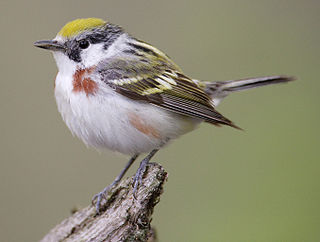
The chestnut-sided warbler is a New World warbler. They breed in eastern North America and in southern Canada westwards to the Canadian Prairies. They also breed in the Great Lakes region and in the eastern United States.

The bay-breasted warbler is a small species of songbird in the New World warbler family, Parulidae. It is one of thirty-four species in the diverse genus Setophaga. Like all songbirds, or passerines, the species is classified in the order Passeriformes.
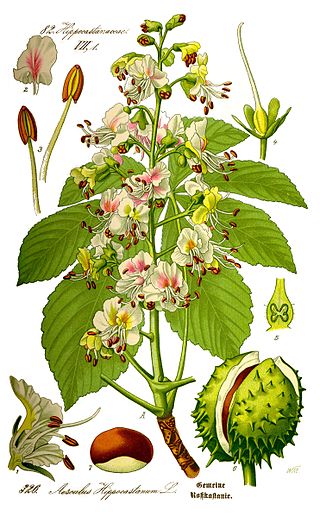
Aesculus hippocastanum, the horse chestnut, is a species of flowering plant in the maple, soapberry and lychee family Sapindaceae. It is a large, deciduous, synoecious (hermaphroditic-flowered) tree. It is also called horse-chestnut, European horsechestnut, buckeye, and conker tree. It is not to be confused with the Spanish chestnut, Castanea sativa, which is a tree in another family, Fagaceae.
Zenkerella perplexa is a species of plant in the family Fabaceae. It is found only in Tanzania, where it is endemic to the Eastern Arc forests.

The chestnut-banded plover is a species of bird in the family Charadriidae. This species has a large range, being distributed across Southern Africa. However, it occupies a rather small area.
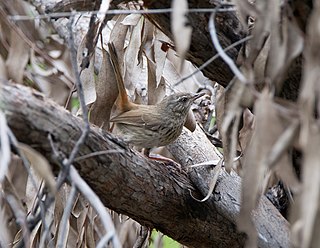
The chestnut-rumped heathwren is a species of bird in the family Acanthizidae. It is endemic to temperate and subtropical forests and heathlands of Australia.
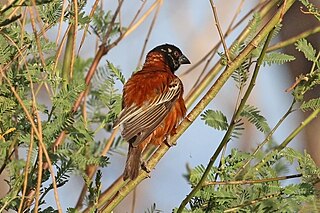
The chestnut weaver is a species of bird in the family Ploceidae. It is found in eastern and south-western Africa.

The chestnut ermine moth is an extinct species of moth in the subfamily Argyresthiinae. It was endemic to the United States. The species was only seen in two states, New Hampshire and Vermont. It became extinct due to chestnut blight obliterating its primary food source, the American chestnut.
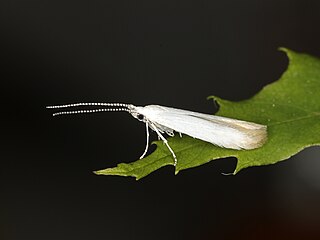
The chestnut casebearer moth is a species of moth in the family Coleophoridae. It is endemic to the United States, where it is found in Indiana, Massachusetts, Pennsylvania, and Virginia. It is a highly specialized species, its larvae feed specifically on the leaves of the American Chestnut. It was thought the species became extinct when many American chestnut trees died due to an infection of the fungus Cryphonectria parasitica, which was accidentally introduced from Asia around 1900. However, this species was rediscovered.
The phleophagan chestnut moth was a species of moth in the family Nepticulidae. It was endemic to the United States, where it was known from Virginia.
Hiraea perplexa is a species of plant in the Malpighiaceae family and is endemic to Ecuador. Its natural habitat is subtropical or tropical moist lowland forests.
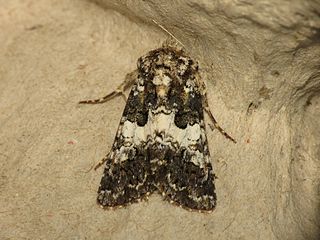
Hadena is a genus of moths of the family Noctuidae erected by Franz von Paula Schrank in 1802. About fifteen species are native to North America, while over one-hundred are distributed in the Palearctic realm.

Hadena perplexa, the tawny shears or pod lover, is a species of moth of the family Noctuidae. It is found in Morocco, Algeria, Tunisia, Europe, Turkey, Israel, Lebanon, Syria, Jordan, Iran, Iraq, northern Asia, Central Asia, northern India and western China.
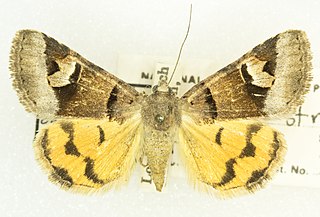
Drasteria perplexa, the perplexing or perplexed arches, is a moth of the family Erebidae. The species was first described by Henry Edwards in 1884. It is found in North America from Alberta and Saskatchewan south to Colorado and Arizona.

Zimmermannia bosquella is a moth of the family Nepticulidae. It is found in Virginia, Ohio, and Kentucky in the United States. It is now classified as conspecific with the American chestnut moth, which was formerly considered as extinct.

Platycopiidae is a family of copepods. Until the description of Nanocopia in 1988, it contained the single genus Platycopia. It now contains four genera, three of which are monotypic; the exception is Platycopia, with 8 species.














